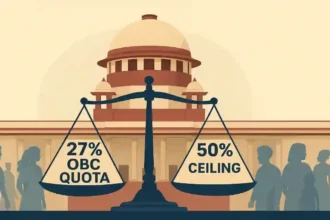
New Delhi – The demand to revise the OBC creamy layer income limit has once again gained momentum, with policymakers, community leaders, and experts stressing that the current income threshold no longer reflects present day economic realities. The creamy layer ceiling determines which Other Backward Classes (OBC) households are eligible for reservation benefits in education and government jobs.
Currently, the OBC creamy layer income limit is set at ₹8 lakh per annum, a figure last revised in 2017 when it was increased from ₹6.5 lakh. According to the existing policy, the income limit is reviewed every three years. However, despite rising inflation, living costs, and changes in the socio-economic structure, the limit has remained unchanged for over seven years.
Why the OBC Creamy Layer Income Limit Needs Revision
Experts argue that stagnant income thresholds are depriving many deserving OBC families of their rightful access to government welfare schemes and reservation benefits. Inflation and a steady rise in salaries across sectors mean that even lower middle class OBC families often cross the ₹8 lakh mark, making them ineligible despite being far from affluent.
A Parliamentary Committee report recently pointed out that the economic status of many OBC households has not improved enough to warrant their exclusion from reservations. The report recommends that the OBC creamy layer income limit should be raised in line with inflation, economic growth, and the evolving job market.
Social justice advocates emphasize that the primary purpose of reservations is to uplift disadvantaged communities. If the income cap remains outdated, it undermines this objective and could further widen socio-economic gaps within the OBC category.

Historical Context of the OBC Creamy Layer
The concept of the “creamy layer” was introduced by the Supreme Court in the landmark Indra Sawhney case of 1992 to ensure that reservation benefits reach the most disadvantaged within OBC communities, not the relatively better-off. The income limit was initially set at ₹1 lakh per annum in 1993 and has been periodically revised since then.
From ₹1 lakh in the 1990s, it rose to ₹2.5 lakh in 2004, ₹4.5 lakh in 2008, ₹6 lakh in 2013, ₹6.5 lakh in 2014, and finally ₹8 lakh in 2017. However, unlike previous intervals, no revision has taken place since 2017.
Parliamentary Recommendations and Government Position
In 2023, a high level parliamentary panel reviewed the issue and suggested that the government should not delay the upward revision. Of the 12 ministries consulted, 10 supported the revision, citing the pressing need for updating eligibility criteria in line with socio-economic conditions.
The committee also suggested that income from agriculture should not be included in the calculation for the OBC creamy layer income limit, as it disproportionately impacts rural OBC families whose cash flow is seasonal and unstable.
Potential New Thresholds Under Discussion

While the government has not officially announced the new figure, policy observers believe the limit could rise anywhere between ₹10 lakh and ₹12 lakh per annum. This would reflect the real cost of living and ensure that reservation benefits reach a broader section of genuinely needy OBC families.
Some experts also recommend linking the income limit to inflation and automatically revising it every three years to avoid political delays.
Economic and Social Impact of the Revision
An increase in the OBC creamy layer income limit will potentially expand reservation benefits to thousands of additional OBC candidates in competitive exams, public sector jobs, and higher education. This could significantly improve the representation of OBCs in elite government services, where their numbers remain below the mandated quota in many states.
Data from the Department of Personnel and Training shows that OBC representation in top civil services is still far from proportional to their population share. By updating the income threshold, the government could correct systemic barriers that prevent capable candidates from accessing opportunities.
Conclusion
The call to revise the OBC creamy layer income limit is not just a bureaucratic formality—it is a social justice imperative. An outdated threshold not only disqualifies deserving candidates but also undermines the constitutional vision of equality and affirmative action. With the parliamentary committee’s recommendations on the table and mounting public pressure, the government is expected to take a decision soon.
If implemented wisely, the revision could ensure that reservation benefits truly reach those who need them the most, thereby fulfilling the core purpose of the OBC quota system in India’s democratic framework.
Stay connected with The News Drill for more updates. Stay informed. Stay updated. Stay Ahead.







